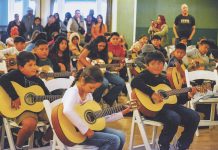
Editor’s note: This is the third entry of a weekly four-part series about the Pajaro Valley’s Japanese community. The series will culminate on Aug. 14, coinciding with this year’s celebration of the Obon Festival, a cultural and religious Japanese event honoring one’s ancestors. Read the first entry here and the second here.
By Hugh McCormick, Special to the Pajaronian
WATSONVILLE—The suffering of Japanese Americans didn’t end with the conclusion of World War II in 1945. Families who returned to the Pajaro Valley faced bitter racism and rampant discrimination. Much of their hard-earned land, agricultural leases, farm equipment and possessions were gone—either sold to the highest bidder for pennies on the dollar or simply taken.
“Some found their belongings, which had been stored by churches or trusted neighbors, while others discovered their homes in disarray, their things stolen or broken,” reported the Pajaronian on Sept. 8, 1945.
According to the head of the local War Relocation Authority (WRA), an organization set up to assist persons of Japanese descent in resettling, “the biggest problem facing local WRA representatives is housing. Hostels will have to be established throughout the area to house the returning Japanese.” Some Japanese families were able to stay at these hostels, while others spent their nights on the floor of the old Buddhist temple on Union Street.
“There were efforts in the (WRA) to try to assist Japanese families, but depending on the place, hostility was such that no WRA committee could overcome,” said Sandy Lydon, Historian Emeritus at Cabrillo College.
One of the largest economic impacts on the Japanese during World War II was the reassignment or cancelation of agricultural leases. An agent from the Farm Security Administration swept into the Pajaro Valley just days after the area’s Japanese were imprisoned. His sole job was to assist anyone (non-Japanese) wanting to farm Japanese land. Close to 70% of the land tended by the Japanese was leased—much with the help or aid of the United States government. During the war, the majority of the leases were terminated, leaving many returning families landless and destitute.
Pajaro Valley’s Japanese community lost other economic niches during the war too, namely fishing. During their time in Arizona’s Poston Camp II, a law was passed that barred all those of Japanese ancestry from acquiring commercial fishing licenses. The once-flourishing Japanese abalone and sardine industry was destroyed almost overnight.
After their three-year incarceration, returning Japanese faced the most hate and animosity in agricultural valleys where people feared competition from returning Japanese farmers, Lydon said. Salinas was one of the least receptive areas on the Central Coast. “No Japs Wanted” signs were a common sight, and many Japanese were unwelcome at barbershops and gas stations.
It was difficult for some to separate Japanese Americans from the Japanese Army in the Pacific.
“There was so much hate and discrimination here after the war. We all felt it. People were stuck in their ways,” said Goro Yamashita, owner/proprietor of Yamashita Grocery in Watsonville. “Watsonville was never the same for us. I remember my mom dealing with it. People would see her and refuse to sell to her. Like butter and things she really needed.”
There was a pervasive sense of shame, loss of personal honor and resignation among the region’s Japanese population following the war, Lydon said. The Japanese community was keenly aware of the gigantic precedent set by their imprisonment without the benefit of jury or trial. That changed everything, and older Japanese mark their lives “Before Camp” and “After Camp.”
World War II marked the end of regional Japantowns like Watsonville’s “Nihonmachi.”
“Some closed the day after Pearl Harbor. And many Japanese businesses had liquidation sales. A large number of Japanese believed that the Nihonmachi’s were the problems. Being concentrated and visible made it easy for the government, or racists, to find and arrest them,” Lydon said.
In California, there were 43 Japantowns before the war. Now there are only three.
“Little Tokyo in Los Angeles, San Jose and San Francisco,” said Mas Hashimoto. “Now, the only part of Watsonville’s [that is left] is Yamashita’s.”
Many Japanese emigrants threw in the proverbial towel—fleeing the Pajaro Valley for greener and more welcoming pastures. It’s estimated that only one-third of Japanese residents living in the region returned after the war. The congregation of Watsonville’s Buddhist Temple that numbered in the hundreds in 1940 dropped to dozens in 1945.
“Most of us didn’t have a place to come home to. Two-thirds went elsewhere. Denver, Philadelphia… places they were welcomed. California was a racist state. My brother said he would not come back to California—except to take his kids to Disneyland, or my mom’s funeral. The state didn’t start changing until the 1960s,” Hashimoto said.
During the Japanese internment, the produce giants of the Pajaro Valley scrambled to find workers for their fields. Enter: Mexico. The valley’s ag-machine attracted thousands of Mexican migrant workers. And just like the Chinese and Japanese emigrants of decades prior, the Mexicans who settled in Watsonville made it their own.
Mexico and the United States signed the groundbreaking Mexican Farm Labor Agreement—creating what is today known as the “Bracero Program”—in August of 1942. The ultimate goal of the program, which literally means “manual laborer,” was to fill a severe labor shortage in the nation’s fruit orchards and vegetable fields during the war. To replace the Japanese.
“We were gone. There was a labor shortage. They brought in seasonal guest workers to harvest the crops. Many stayed, and brought their families. Why not? This is a great place,” Hashimoto said.
Mexican nationals, desperately seeking work of any kind, were promised comfortable living conditions in American labor camps—with adequate food, sanitation and shelter, and a minimum wage of 30 cents an hour. Close to 200,000 braceros answered the call and were imported each year from 1942 to 1964 (when the agreement expired).
Because they were more than willing to work long and hard hours for wages typically scorned by most Americans, braceros quickly emerged as an integral part of the Pajaro Valley’s economy—long outlasting World War II. The effects of the Bracero Program can still be seen throughout Monterey Bay, especially in Watsonville and the Pajaro Valley.
When the Bracero Program ended in 1964, a large number of Mexican farmworkers, and their families, chose to migrate to the U.S., settling in agricultural areas like the Pajaro Valley. A strong labor market relationship between Mexico and the U.S. had been established, and institutionalized networks spawned—U.S. companies needed workers and Mexican nationals needed jobs. The symbiosis that developed between Mexico and the United States during that era was the foundation of the migration from Mexico that is seen today.
The population of Watsonville today is mostly Latinx—close to 85% according to recent Census data. In the late 1930s and early 1940s, close to one-third of graduates of Watsonville High School were Japanese Americans. Today, it’s rare to have more than a handful of Japanese Americans in a graduating class. Taquerias have replaced noodle houses, and soccer has replaced baseball.
But there are still a few vestiges of Japanese culture left in the city, and the Pajaro Valley region.
The Buddhist Temple, originally constructed on the corner of Union and Bridge Streets in 1906, is now relocated to the corner of Blackburn and Bridge streets. A small gate—the last trace of the once-treasured original Buddhist Temple—was removed this year. In its place is a grey electric transformer box.
The Japanese Presbyterian Church, where the Salvation Army currently sits on Union Street, moved to the Westside of First Street in 1929 and changed its name to Westview Presbyterian Church. Its congregation, with many Japanese members, remains a vital part of the community to this day.
A solitary redwood tree, planted by the Japanese Association decades ago, stands where Toyo Hall—the famed Japanese community hall—used to be near the Union Street entrance to Burger King. The center of what was formerly Japantown (Nihonmachi) sits where Burger King on Main Street is currently located.
Following Tokyo Mayor Yuko Ozaki’s heartfelt donation of thousands of Japanese cherry trees to the city of Washington D.C. in 1912, Watsonville’s Japanese Association donated hundreds of its own cherry trees to the city and its surrounding schools. Many of the trees were vandalized or destroyed during World War II, and only three remained when the city’s Japanese returned from their internment in Arizona.
This past winter, the last remaining cherry tree died.
Like those relics, some in the once-strong Japanese community never recovered after the war.
“Most of the Japanese people in Watsonville—adults and kids—are gone. They just moved on. They needed, or wanted, to leave the area. Or didn’t want to go into agriculture or farming. They moved and didn’t come back,” Yamashita said.
•••
In the final entry of the series, we return to Yamashita Grocery to see how it has survived through decades of change.











